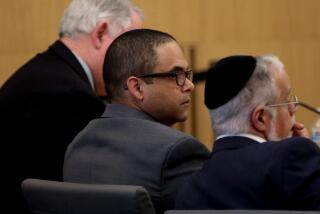Both Sides Agree to Let the Judge Decide in Second Lam Trial
- Share via
Both sides in the second trial of a Vietnamese student accused of murder in the death of Cal State Fullerton professor Edward Lee Cooperman agreed Wednesday to let the judge decide the verdict, instead of a jury. Both sides say it will at least eliminate the chances of another hung jury.
The new jury had already been impaneled and was waiting for opening statements Wednesday when attorneys came out of Superior Court Judge Richard J. Beacom’s chambers with the announcement.
Minh Van Lam, a 21-year-old refugee and former student of Cooperman, has admitted fatally shooting the professor on Oct. 13, 1984, but claims it was an accident. He claims the two were practicing defense moves with a pistol when the professor grabbed his arm to show him how to aim it, and the weapon discharged.
Cooperman’s friends and family, convinced that the professor was the victim of a political assassination because of his ties to communist Vietnam, were stunned by the decision to dismiss the jury. They also were dismayed to learn that the prosecution did not plan to present any new evidence.
In Lam’s first trial, which ended in a hung jury, the vote was 9 for involuntary manslaughter and 3 for acquittal on all charges. Beacom, who heard the first trial, eliminated a finding of first-degree murder from the second trial because the first jury unanimously ruled it out. But Beacom is allowing the prosecution to seek a second-degree murder conviction.
Beacom will base his verdict essentially on evidence presented at the first trial.
Chief Deputy Dist. Atty. James Enright put on three minor witnesses Wednesday after Beacom dismissed the jury, and defense attorneys Alan May and George Chula are expected to put on just one witness today. Beacom said in court that the case probably would be resolved sometime today.
It’s not unusual for attorneys in a criminal case to agree to a non-jury trial when the first trial ends in a hung jury. But it rarely happens after a jury for the second trial has been empaneled.
Ironically, the discussion about a non-jury trial came during a closed-door session among attorneys over a possible new prosecution witness.
Opening statements to the second jury probably would have begun last Monday but were delayed after a jailhouse informant went to authorities to say that Lam had made incriminating statements to him while both were in jail.
During closed discussions about the informant, Paul David Cisneros, defense attorney May reportedly threatened to seek a new jury because he had not had a chance to ask jurors about their views on the credibility of jailhouse informants.
May said after court Wednesday that the discussion about the informant led Chula and Enright, longtime courtroom adversaries, to question whether the second trial required a jury at all.
Enright has refused to comment because of Beacom’s order that the attorneys not discuss the case with the news media.
“We think Judge Beacom’s a good judge, and that’s all I’ll say,” Enright said.
Enright told the court he did not consider Cisneros’ information to police of value to the prosecution but brought it to the court’s attention because of his obligation to inform the defense about any new developments. Beacom said Cisneros’ statements were “ambiguous” at best and would have little or no weight with him.
Cooperman’s widow, Klaaske Cooperman, and one of her two teen-age daughters present in court, were concerned about the effect of a non-jury trial. She said after talking with Enright that apparently the prosecution feared that the case might be dismissed altogether if a second jury couldn’t agree on a verdict. That problem is eliminated if the judge is allowed to decide the case, Enright reportedly said.
The defense is reportedly confident that Beacom will issue a verdict no more serious than involuntary manslaughter, based on the fact that the prosecution has produced no new evidence.
The defense offered one piece of evidence that had been a mystery at the first trial and concerned who owned the .25-caliber pistol used in the professor’s death. Both sides stipulated Wednesday that Cooperman had purchased .25-caliber bullets from a gun store owner in Fullerton just a month before he was shot, an indication that it was probably his gun, as Lam has claimed.
More to Read
Sign up for Essential California
The most important California stories and recommendations in your inbox every morning.
You may occasionally receive promotional content from the Los Angeles Times.













